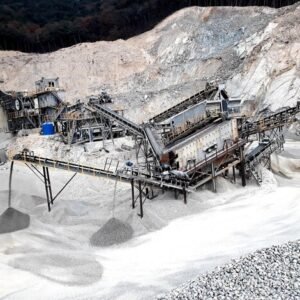By incorporating bentonite into the soil, the resistivity of the soil and the ground resistance of the electrodes are decreased. Bentonite is a clay that is created by the activity of volcanoes. It has fine grains and high plasticity. This substance can serve as a substitute for soil and as a filler material for electrical grounding in areas with high resistance.
Montmorillonite has been activated with sodium. Bentonite clay, which is conductive. Bentonite continues to maintain its qualities throughout time, in addition to being chemically hydrated and naturally stable.
Bentonite can often expand its dry volume due to its ability to absorb moisture from the soil around it. To reduce the contact resistance and artificially increase the diameter of the grounding rods and cables that have been put in trenches, it adheres to the surface of the grounding rods and cables.
How Does Bentonite React?
The following are some of the significant observations about the reaction of Bentonite:
- When water is present in bentonite, the resistivity of the material changes, and the electrical currents pass through the bentonite because of the water inside the pores.
- The resistivity value is lower in the liquid state than in the plastic or solid-state, and it is around 250 Ω∙cm when the moisture content is 300% when the liquid state is present.
- Bentonite compound has a moisture retention mechanism that protects against corrosion. This is in addition to the fact that it lowers the resistance of rods and cables to grounding.
Also Read: – Bentonite for pond construction
Factors Affecting the Performance of Bentonite
The quantity of rainfall, the moisture content of the soil, and the temperature at the location all significantly impact the performance of bentonite. Hot weather causes the soil to dry up, which results in the bentonite not functioning as well as it could. It can get detached from the electrodes, increasing the resistance to the ground.
The ground improvement material (GEM) known as bentonite is extensively used and readily accessible inside the market. Because of its capacity to take in moisture, it is the most effective alternative for a good grounding system in high-resistance soil, particularly rocky soil.
For grounding, two components make up the lightning protection system: the ground electrode and the ground medium. It is recommended that the best ground electrode be used to design an effective grounding system. This high conductivity electrode allows the surge current to be grounded in less time.
In addition to this, the electrode must be able to endure the corrosion process that occurs in the soil for it to have a longer lifespan. Additionally, the electrode must be mechanically robust to withstand the recurrent fault and surge current.
Also Read: – Bentonite manufacturers in india
Bentonite’s Absorption Rates to Consider
At a density of six times its dry volume, the earthing compound is highly thick and in a pasty clay state that may hold form and stick to surfaces. Bentonite can absorb up to five times its weight in water, and the clay that retains moisture will expand to thirteen times its dry volume.
The clay compound known as bentonite is non-corrosive, naturally stable, and will maintain its qualities over time. Bentonite hydrates chemically, which means that it retains water inside its structure.
After the duct-filling process, the earthing compound mixture should be injected into the cable duct to ensure that air is excluded. Once the duct filling process is complete, all ducts should be sealed to prevent any leakage or escape of the Bentonite. Granular or powdered forms of the earthing compound are available for purchase, and the compound’s expansion ratio, when combined with water, is typically 2:1.
Granular Bentonite is the preferred option for filling trenches because the substance can be mixed in the cable trench. Powder Bentonite, on the other hand, is suitable for pouring into boreholes to ensure that the mixture is thin enough to reach the bottom of the hole. Granular Bentonite is easier to handle, process, and use than powder-type compounds.
Advantages of Bentonite Clay for Grounding and Electrical Earthing Compound
The following are the advantages of Bentonite when used for earthing enhancement:
Reduces Resistance
Bentonite is used to reduce the resistance to earth by providing ground augmentation. This is accomplished by successfully lowering the resistance between the soil and earth electrodes (such as copper earth rods or earth mats) by retaining moisture within the soil.
Positive Association
There is a positive association between the electrical conductivity of the earthing compound and the local climatic circumstances, notably the average rainfall levels. This intrinsic tendency to absorb and retain rainwater improves the property of the earthing compound.
Cost-efficient material
Bentonite compound is a cost-efficient material for backfilling earth electrodes and improving performance when it is physically impossible to drive the earth rods deeper and where challenging ground conditions exist, such as rock, granite, and other similar situations. The compound generally has a resistivity level of three ohms.m.
Lowers Ground resistance
Chemical treatment or backfilling of the soil near an underground earthing electrode is a well-established and time-honored method of lowering ground resistance for substation earthing on high-resistivity ground. This type of soil backfilling for electrical grounding improvements is commonly used on low-voltage, medium-voltage, and high-voltage applications.
Wrapping Up!
There is no precise mixing ratio, which varies according to local electrical utility and DNO engineering standards and preferences related to the earthing compound’s ground conditions and resistivity readings. The plasticity and viscosity of the earthing compound ensure that the utility or civil engineering contractor will have an easy time installing and using the earthing compound. It is necessary to completely and violently mix the compound with water to obtain an equal consistency in the form of a slurry suitable for dumping into the cable trench, borehole, or job site.







